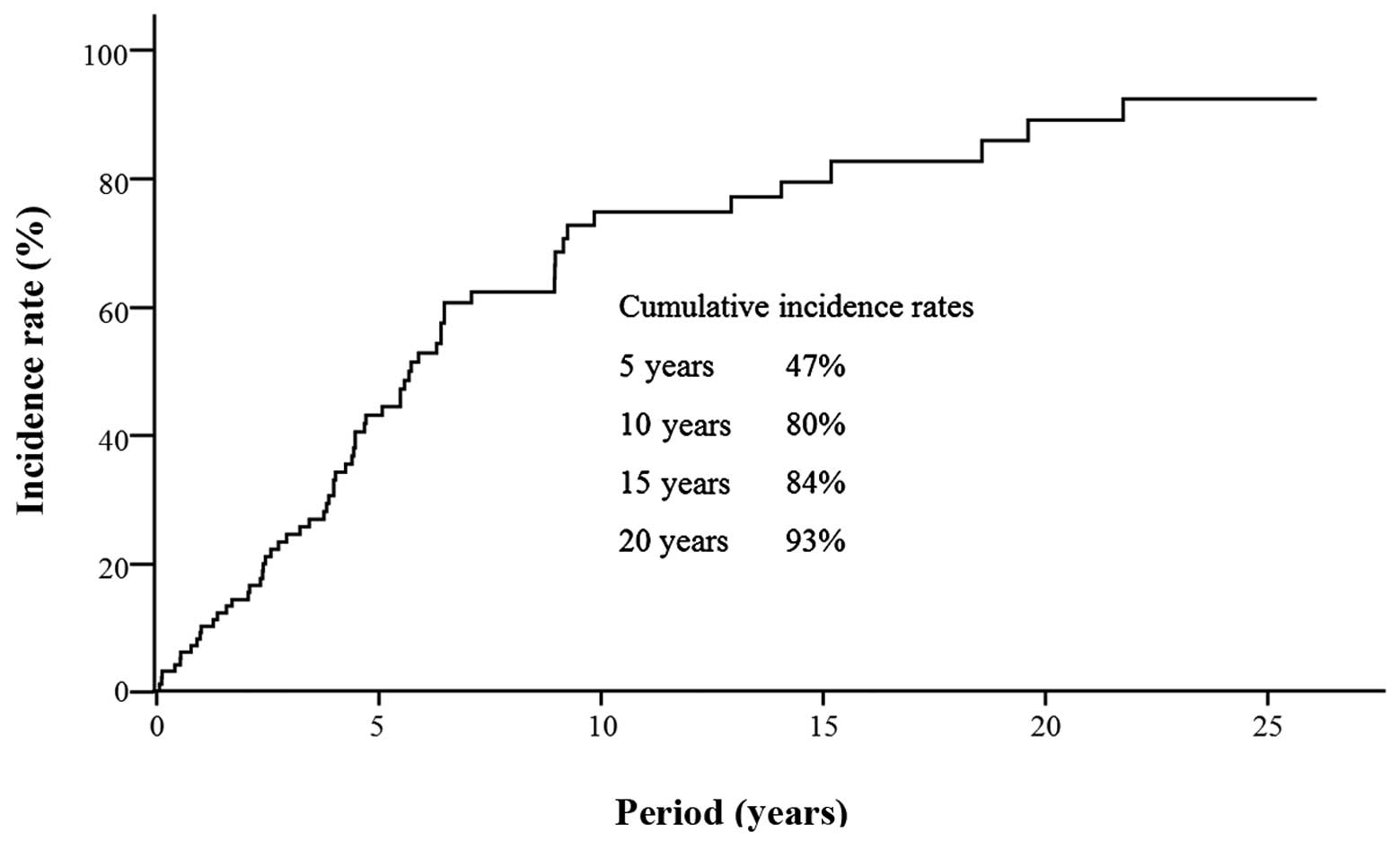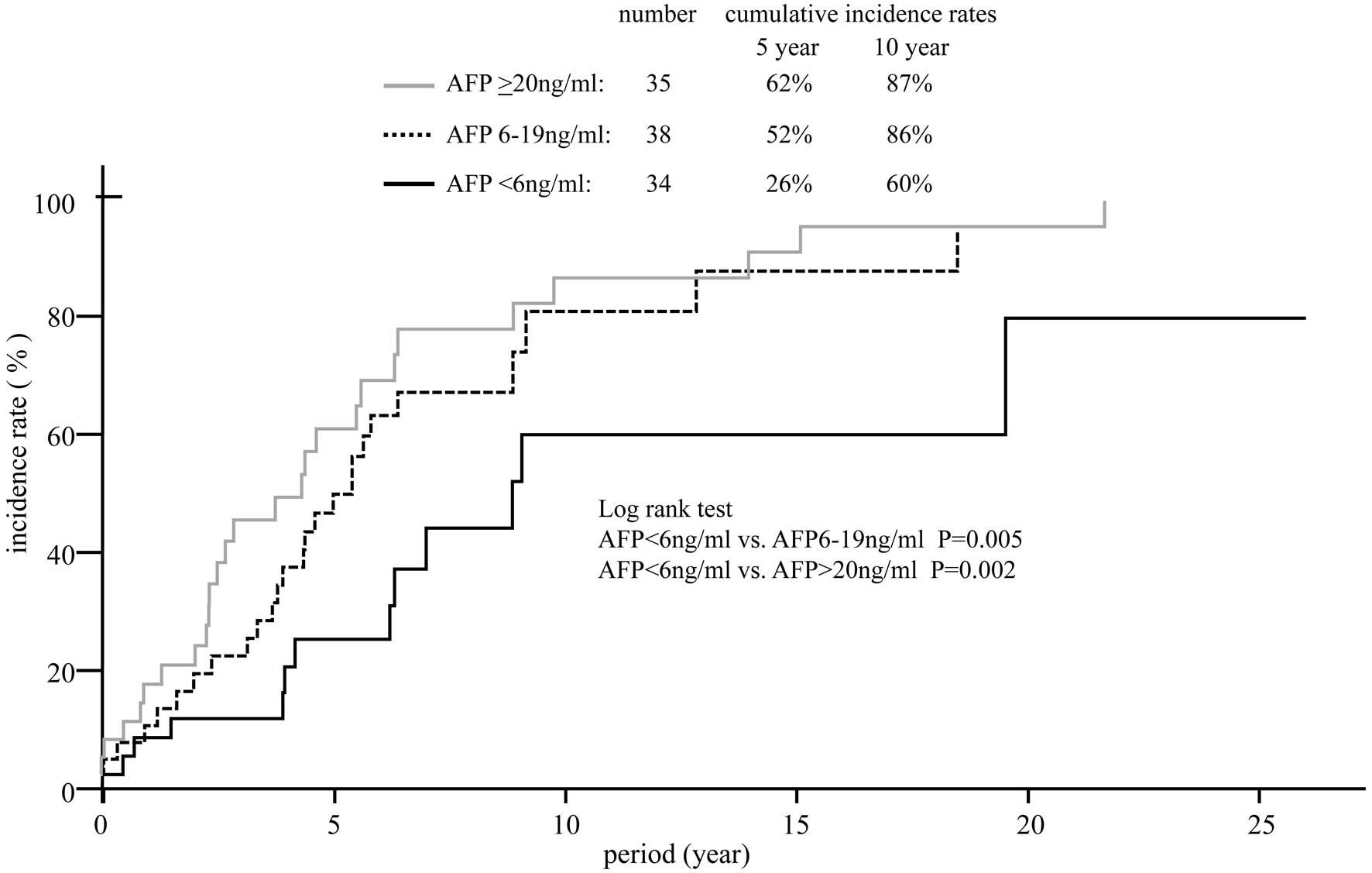|
1
|
El-Serag HB and Mason AC: Risk factors for
the rising rates of primary liver cancer in the United States. Arch
Intern Med. 160:3227–3230. 2000. View Article : Google Scholar : PubMed/NCBI
|
|
2
|
El-Serag HB: Epidemiology of
hepatocellular carcinoma. Clin Liver Dis. 5:87–107. vi2001.
View Article : Google Scholar : PubMed/NCBI
|
|
3
|
El-Serag HB, Hampel H, Yeh C and Rabeneck
L: Extrahepatic manifestations of hepatitis C among United States
male veterans. Hepatology. 36:1439–1445. 2002. View Article : Google Scholar : PubMed/NCBI
|
|
4
|
El-Serag HB: Hepatocellular carcinoma and
hepatitis C in the United States. Hepatology. 36(Suppl 1): S74–S83.
2002. View Article : Google Scholar : PubMed/NCBI
|
|
5
|
El-Serag HB: Hepatocellular carcinoma: an
epidemiologic view. J Clin Gastroenterol. 35(Suppl 2): S72–S78.
2002. View Article : Google Scholar : PubMed/NCBI
|
|
6
|
Hassan MM, Frome A, Patt YZ and El-Serag
HB: Rising prevalence of hepatitis C virus infection among patients
recently diagnosed with hepatocellular carcinoma in the United
States. J Clin Gastroenterol. 35:266–269. 2002. View Article : Google Scholar
|
|
7
|
El-Serag HB and Rudolph KL: Hepatocellular
carcinoma: epidemiology and molecular carcinogenesis.
Gastroenterology. 132:2557–2576. 2007. View Article : Google Scholar : PubMed/NCBI
|
|
8
|
Kiyosawa K and Tanaka E: Characteristics
of hepatocellular carcinoma in Japan. Oncology. 62:5–7. 2002.
View Article : Google Scholar
|
|
9
|
McGlynn KA, Tsao L, Hsing AW, Devesa SS
and Fraumeni JF Jr: International trends and patterns of primary
liver cancer. Int J Cancer. 94:290–296. 2001. View Article : Google Scholar : PubMed/NCBI
|
|
10
|
Bosch FX, Ribes J, Díaz M and Cléries R:
Primary liver cancer: worldwide incidence and trends.
Gastroenterology. 127:S5–S16. 2004. View Article : Google Scholar : PubMed/NCBI
|
|
11
|
Hamasaki K, Nakata K, Tsutsumi T, et al:
Changes in the prevalence of hepatitis B and C infection in
patients with hepatocellular carcinoma in the Nagasaki Prefecture,
Japan. J Med Virol. 40:146–149. 1993. View Article : Google Scholar : PubMed/NCBI
|
|
12
|
Kato Y, Nakata K, Omagari K, et al: Risk
of hepatocellular carcinoma in patients with cirrhosis in Japan.
Analysis of infectious hepatitis viruses. Cancer. 74:2234–2238.
1994. View Article : Google Scholar : PubMed/NCBI
|
|
13
|
Shiratori Y, Shiina S, Imamura M, et al:
Characteristic difference of hepatocellular carcinoma between
hepatitis B- and C- viral infection in Japan. Hepatology.
22:1027–1033. 1995. View Article : Google Scholar : PubMed/NCBI
|
|
14
|
Shiratori Y, Shiina S, Zhang PY, et al:
Does dual infection by hepatitis B and C viruses play an important
role in the pathogenesis of hepatocellular carcinoma in Japan?
Cancer. 80:2060–2067. 1997. View Article : Google Scholar : PubMed/NCBI
|
|
15
|
Nomura H, Kashiwagi Y, Hirano R, et al:
Efficacy of low dose long-term interferon monotherapy in aged
patients with chronic hepatitis C genotype 1 and its relation to
alpha-fetoprotein: A pilot study. Hepatol Res. 37:490–497. 2007.
View Article : Google Scholar : PubMed/NCBI
|
|
16
|
Taketa K: Alpha-fetoprotein: reevaluation
in hepatology. Hepatology. 12:1420–1432. 1990. View Article : Google Scholar : PubMed/NCBI
|
|
17
|
Di Bisceglie AM: Hepatitis C and
hepatocellular carcinoma. Hepatology. 26(Suppl 1): 34S–38S.
1997.
|
|
18
|
Sherman M: Hepatocellular carcinoma:
epidemiology, risk factors, and screening. Semin Liver Dis.
25:143–154. 2005. View Article : Google Scholar : PubMed/NCBI
|
|
19
|
Rodríguez-Díaz JL, Rosas-Camargo V,
Vega-Vega O, et al: Clinical and pathological factors associated
with the development of hepatocellular carcinoma in patients with
hepatitis virus-related cirrhosis: a long-term follow-up study.
Clin Oncol (R Coll Radiol). 19:197–203. 2007.
|
|
20
|
Bruix J and Sherman M; Practice Guidelines
Committee: American Association for the Study of Liver Disease:
Management of hepatocellular carcinoma. Hepatology. 42:1208–1236.
2005. View Article : Google Scholar : PubMed/NCBI
|
|
21
|
Colombo M, de Franchis R, Del Ninno E, et
al: Hepatocellular carcinoma in Italian patients with cirrhosis. N
Engl J Med. 325:675–680. 1991. View Article : Google Scholar : PubMed/NCBI
|
|
22
|
Tsukuma H, Hiyama T, Tanaka S, et al: Risk
factors for hepatocellular carcinoma among patients with chronic
liver disease. N Engl J Med. 328:1797–1801. 1993. View Article : Google Scholar : PubMed/NCBI
|
|
23
|
Oka H, Tamori A, Kuroki T, Kobayashi K and
Yamamoto S: Prospective study of alpha-fetoprotein in cirrhotic
patients monitored for development of hepatocellular carcinoma.
Hepatology. 19:61–66. 1994. View Article : Google Scholar : PubMed/NCBI
|
|
24
|
Ganne-Carrié N, Chastang C, Chapel F, et
al: Predictive score for the development of hepatocellular
carcinoma and additional value of liver large cell dysplasia in
Western patients with cirrhosis. Hepatology. 23:1112–1118.
1996.PubMed/NCBI
|
|
25
|
Sangiovanni A, Colombo E, Radaelli F, et
al: Hepatocyte proliferation and risk of hepatocellular carcinoma
in cirrhotic patients. Am J Gastroenterol. 96:1575–1580. 2001.
View Article : Google Scholar : PubMed/NCBI
|
|
26
|
Tateyama M, Yatsuhashi H, Taura N, et al:
Alpha-fetoprotein above normal levels as a risk factor for the
development of hepatocellular carcinoma in patients infected with
hepatitis C virus. J Gastroenterol. 46:92–100. 2011. View Article : Google Scholar : PubMed/NCBI
|
|
27
|
Mizejewski GJ, Dias JA, Hauer CR,
Henrikson KP and Gierthy J: Alpha-fetoprotein derived synthetic
peptides: assay of an estrogen-modifying regulatory segment. Mol
Cell Endocrinol. 118:15–23. 1996. View Article : Google Scholar : PubMed/NCBI
|
|
28
|
Li M, Li H, Li C, et al: Alpha fetoprotein
is a novel protein-binding partner for caspase-3 and blocks the
apoptotic signaling pathway in human hepatoma cells. Int J Cancer.
124:2845–2854. 2009. View Article : Google Scholar : PubMed/NCBI
|
|
29
|
Li M, Li H, Li C, et al:
Alpha-fetoprotein: a new member of intra-cellular signal molecules
in regulation of the PI3K/AKT signaling in human hepatoma cell
lines. Int J Cancer. 128:524–532. 2011. View Article : Google Scholar : PubMed/NCBI
|
|
30
|
Yang X, Zhang Y, Zhang L, Zhang L and Mao
J: Silencing alpha-fetoprotein expression induces growth arrest and
apoptosis in human hepatocellular cancer cell. Cancer Lett.
271:281–293. 2008. View Article : Google Scholar : PubMed/NCBI
|
|
31
|
Li M, Li H, Li C, et al: Cytoplasmic
alpha-fetoprotein functions as a co-repressor in RA-RAR signaling
to promote the growth of human hepatoma Bel 7402 cells. Cancer
Lett. 285:190–199. 2009. View Article : Google Scholar : PubMed/NCBI
|
|
32
|
Yoshida H, Shiratori Y, Moriyama M, et al:
Interferon therapy reduces the risk for hepatocellular carcinoma:
national surveillance program of cirrhotic and noncirrhotic
patients with chronic hepatitis C in Japan. IHIT Study Group
Inhibition of Hepatocarcinogenesis by Interferon Therapy. Ann
Intern Med. 131:174–181. 1999. View Article : Google Scholar
|
|
33
|
Fattovich G, Stroffolini T, Zagni I and
Donato F: Hepatocellular carcinoma in cirrhosis: incidence and risk
factors. Gastroenterology. 127(Suppl 1): S35–S50. 2004. View Article : Google Scholar : PubMed/NCBI
|
|
34
|
Nishiguchi S, Kuroki T, Nakatani S, et al:
Randomised trial of effects of interferon-alpha on incidence of
hepatocellular carcinoma in chronic active hepatitis C with
cirrhosis. Lancet. 346:1051–1055. 1995. View Article : Google Scholar : PubMed/NCBI
|
|
35
|
Yu ML, Huang CF, Dai CY, Huang JF and
Chuang WL: Long-term effects of interferon-based therapy for
chronic hepatitis C. Oncology. 72(Suppl 1): 16–23. 2007. View Article : Google Scholar : PubMed/NCBI
|
|
36
|
Imai Y, Kawata S, Tamura S, et al:
Relation of interferon therapy and hepatocellular carcinoma in
patients with chronic hepatitis C. Osaka Hepatocellular Carcinoma
Prevention Study Group. Ann Intern Med. 129:94–99. 1998. View Article : Google Scholar
|
|
37
|
Kasahara A, Hayashi N, Mochizuki K, et al:
Risk factors for hepatocellular carcinoma and its incidence after
interferon treatment in patients with chronic hepatitis C. Osaka
Liver Disease Study Group. Hepatology. 27:1394–1402. 1998.
View Article : Google Scholar
|
|
38
|
Ikeda K, Saitoh S, Arase Y, et al: Effect
of interferon therapy on hepatocellular carcinogenesis in patients
with chronic hepatitis type C: A long-term observation study of
1,643 patients using statistical bias correction with proportional
hazard analysis. Hepatology. 29:1124–1130. 1999. View Article : Google Scholar
|
|
39
|
Okanoue T, Itoh Y, Kirishima T, et al:
Transient biochemical response in interferon therapy decreases the
development of hepatocellular carcinoma for five years and improves
the long-term survival of chronic hepatitis C patients. Hepatol
Res. 23:62–77. 2002.
|
|
40
|
Hino K and Okita K: Interferon therapy as
chemoprevention of hepatocarcinogenesis in patients with chronic
hepatitis C. J Antimicrob Chemother. 53:19–22. 2004. View Article : Google Scholar : PubMed/NCBI
|
|
41
|
Valla DC, Chevallier M, Marcellin P, et
al: Treatment of hepatitis C virus-related cirrhosis: a randomized,
controlled trial of interferon alpha-2b versus no treatment.
Hepatology. 29:1870–1875. 1999. View Article : Google Scholar : PubMed/NCBI
|
|
42
|
Cammà C, Di Bona D and Craxì A: The impact
of antiviral treatments on the course of chronic hepatitis C: an
evidence-based approach. Curr Pharm Des. 10:2123–2130.
2004.PubMed/NCBI
|
|
43
|
Shiffman ML, Hofmann CM, Contos MJ, et al:
A randomized, controlled trial of maintenance interferon therapy
for patients with chronic hepatitis C virus and persistent viremia.
Gastroenterology. 117:1164–1172. 1999. View Article : Google Scholar : PubMed/NCBI
|
|
44
|
Murashima S, Tanaka M, Haramaki M, et al:
A decrease in AFP level related to administration of interferon in
patients with chronic hepatitis C and a high level of AFP. Dig Dis
Sci. 51:808–812. 2006. View Article : Google Scholar : PubMed/NCBI
|
|
45
|
Yano H, Iemura A, Haramaki M, et al:
Interferon alpha receptor expression and growth inhibition by
interferon alpha in human liver cancer cell lines. Hepatology.
29:1708–1717. 1999. View Article : Google Scholar : PubMed/NCBI
|
















